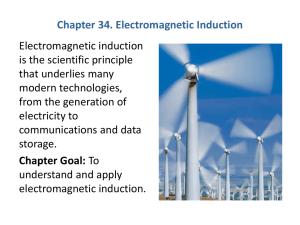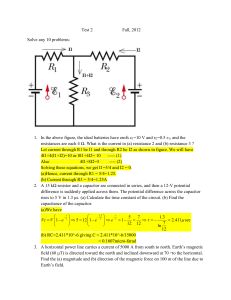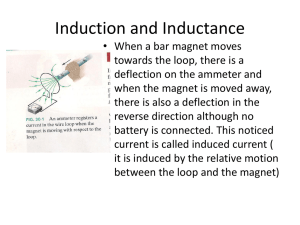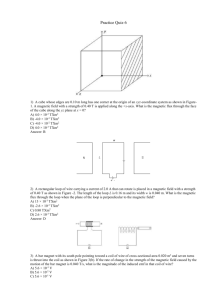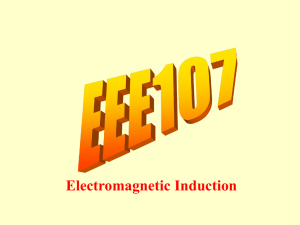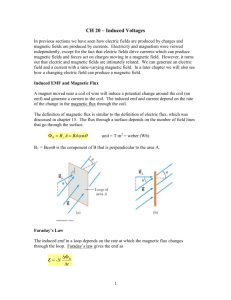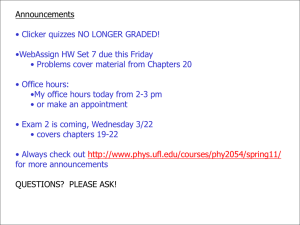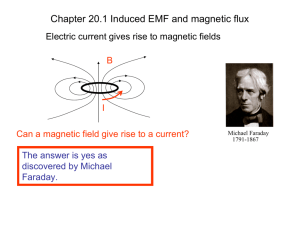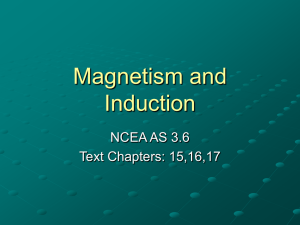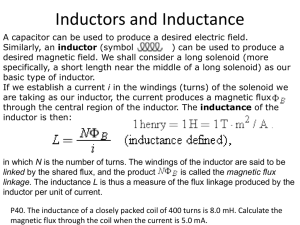Chapter 20: Electromagnetic Induction
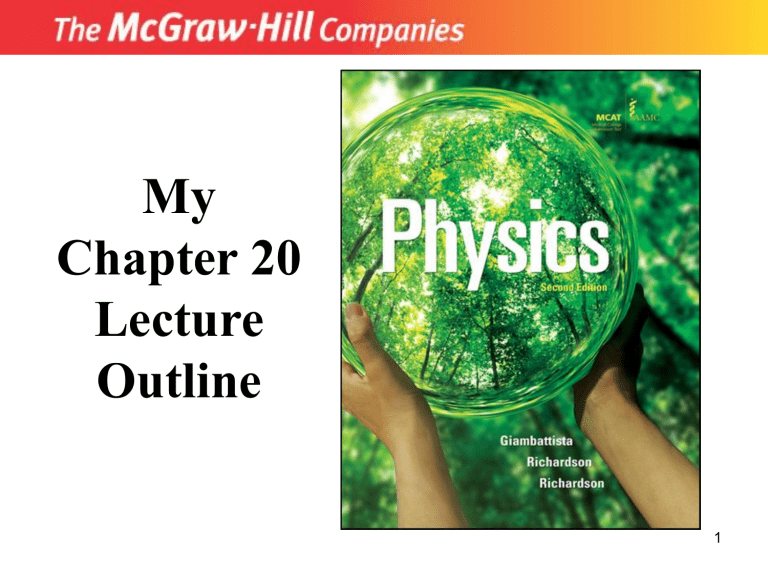
My
Chapter 20
Lecture
Outline
1
Chapter 20: Electromagnetic
Induction
•Motional EMF
•Electric Generators
•Faraday’s Law
•Lenz’s Law
•Transformers
•Eddy Currents
•Induced Electric Fields
•Mutual- and Self-Inductance
•LR Circuits
2
§ 20.1 Motional EMF
Consider a conductor in a B-field moving to the right.
V
3
F
B
q
v
B
An electron in the conductor experiences a force downward. e -
F
V
The electrons in the bar will move toward the bottom of the bar.
This creates an electric field in the bar and results in a potential difference between the top and bottom of the bar.
4
What if the bar were placed across conducting rails (in red) so that there is a closed loop for the electrons to follow?
V
L
In this circuit, the electrons flow clockwise; the current is counterclockwise.
5
The motional EMF is
vBL where L is the separation between the rails.
The current in the rod is I
V
R
R
vBL
R where R is the resistance in the “wires”.
6
The rod has a current through it. What is the direction of the magnetic force on the rod due to the external magnetic field?
F
I
L
B
The magnitude of the magnetic force on the rod is:
F
ILB sin 90
ILB
vBL
LB
R vB
2
L
2
R
Using the right hand rule, the force on the bar is directed to the left.
7
To maintain a constant EMF, the rod must be towed to the right with constant speed. An external agent must do work on the bar. (Energy conservation)
8
§20.2 Electric Generators
A coil of wire is spun in a magnetic field. This produces an EMF and also a current; both vary with time. (ACalternating current)
An energy source is needed to turn the wire coil. Examples include burning coal or natural gas to produce steam; falling water.
9
The EMF produced by an AC generator is:
0 sin
t
In the United States and Canada
0
/2
= 60 Hz.
= 170 volts and f =
10
§20.3 Faraday’s Law
Moving a conductor through a B-field will generate an EMF.
Another way to generate an EMF is to place a stationary conductor in a B-field that varies with time.
11
The magnetic flux is proportional to the number of B-field lines that cross a given area.
B
BA cos
The unit of magnetic flux is the weber: 1 Wb = 1 Tm 2
Loop of wire with area A
12
Faraday’s Law:
N
B
t
An induced EMF in a “coil” of N loops is due to a changing magnetic flux.
Ways to induce an EMF:
1. Vary the magnetic field.
2. Vary the area of the coil.
3. Change the angle between B and A.
13
§20.4 Lenz’s Law
The direction of induced EMFs and currents always oppose the change in flux that produced them.
That is, the induced I (and thus induced B) tries to keep the total flux through the loop constant.
14
Example: Towing the bar to the right produced an induced current that was CCW. What is the direction of the induced magnetic field?
V
L
The induced B is out of the page to maintain the flux originally through the loop before the bar started to move to the right (the area of the loop is increasing).
15
Example (text problem 20.15): A long straight wire carrying a steady current is in the plane of a circular loop of wire.
(a) If the loop of wire is moved closer to the wire, what is the direction of the induced current in the wire loop?
I
Wire loop
There is a magnetic field into the page at the location of the loop. As the loop gets closer to the wire there is an increase in flux. To negate this increase in flux, the induced B-field must point out of the page. This requires a CCW current.
16
§20.6 Transformers
Wrap an iron core with wire.
Primary coil
Secondary coil
Apply a varying voltage to the primary coil. This causes a changing magnetic flux in the secondary coil.
1
N
1
B
t
2
N
2
B
t
17
Since the flux through the coils is the same
1
2
N
1
N
2
The “turns ratio” gives the ratio of the EMFs.
Depending on the turns ratio, a transformer can be used to step-up or step-down a voltage.
The rate that power is supplied to both coils is the same
1
2
I
2
I
1
N
N
2
1
18
Example (text problem 20.34): The primary coil of a transformer has 250 turns and the secondary coil has 1000 turns. An AC voltage is sent through the primary. The EMF of the primary is 16.0 V. What is the EMF in the secondary?
1
2
2
N
1
N
2
N
2
N
1
1
1000
250
16 .
0 V
64.0
V
19
§20.7 Eddy Currents
If a conductor is subjected to a changing magnetic flux, a current will flow. (This includes sheets of metal, etc.)
20
Consider a metal plate that swings through a magnetic field.
pivot
X
An external magnetic field into the page created by a magnet.
21
As the plate swings through the region of magnetic field, some regions of the plate are entering the B-field (increasing flux), and other regions of the plate are leaving the B-field
(decreasing flux). There will be induced currents in the conductor called eddy currents.
The eddy currents dissipate energy (according to I 2 R); this results in the damping of the amplitude of the metal sheet.
22
§ 20.9 Mutual- and Self-Inductance
I
A variable current
1 flows in coil 1.
I
1 then induces a current in coil 2.
Coil 1
Coil 2
The flux (
21
) through coil 2 due to coil 1 is N
2
21
I
1
.
23
Writing this as an equality, N
2
21
MI
1
Where M is the mutual inductance. It depends only on constants and geometrical factors. The unit of inductance is the Henry (1H = 1Vs/A).
The induced EMF in the coils will be:
2
1
N
2
N
1
21
t
12
t
M
M
I
t
1
I
t
2
24
Self-inductance occurs when a current carrying coil induces an EMF in itself.
The definition of self-inductance (L) is N
LI .
25
Example (text problem 20.51): The current in a 0.080 Henry solenoid increases from 20.0 mA to 160.0 mA in 7.0 s. Find the average EMF in the solenoid during that time interval.
N
t
L
I
t
160 mA
20 mA
0 .
080 H
7 .
0 s
1 .
6
10
3
V
26
An inductor stores energy in its magnetic field according to:
U
1
2
LI
2
The energy density in a magnetic field is: u
B
1
2
0
B
2
27
§ 20.10 LR Circuits
An inductor and resistor are connected in series to a battery.
As with an RC circuit, the current in the circuit varies with time.
28
The voltage drop across an inductor is given by
L
L
I
t
.
When an inductor is “charging” (the energy stored is increasing) the current in the circuit is:
I ( t )
I f
1
e
t /
I
Where
= L/R is the time constant for the circuit and f
=
b
/R maximum current in the circuit.
29
Applying Kirchhoff’s loop rule to the circuit gives the EMF in the inductor as:
L
b
IR
b e
t /
30
Plots of
L
(t) and I(t) for this LR circuit:
31
For a “discharging” inductor, I ( t )
I
0 e
t /
where I
0 is the current in the inductor when t = 0.
The LR circuit time constant
plays the same role as in an RC circuit.
32
Summary
•Motional EMF
•Faraday’s Law
•Lenz’s Law
•Transformers
•Eddy Currents
•Inductance and Inductors
•LR Circuits
33

